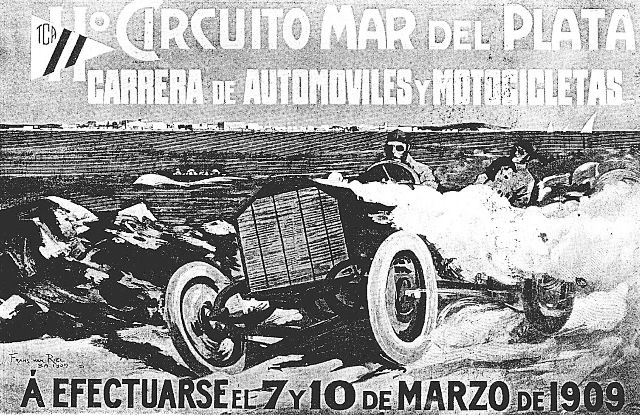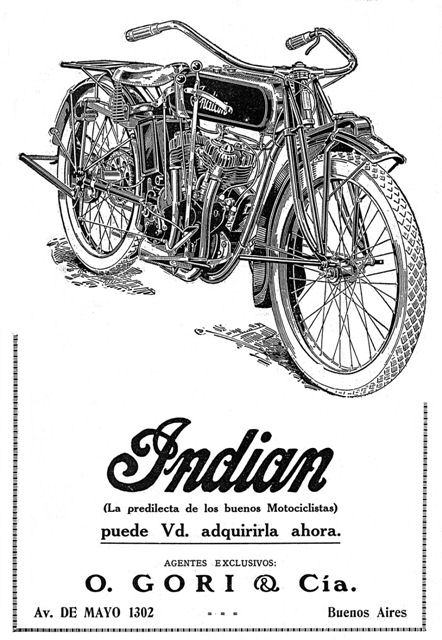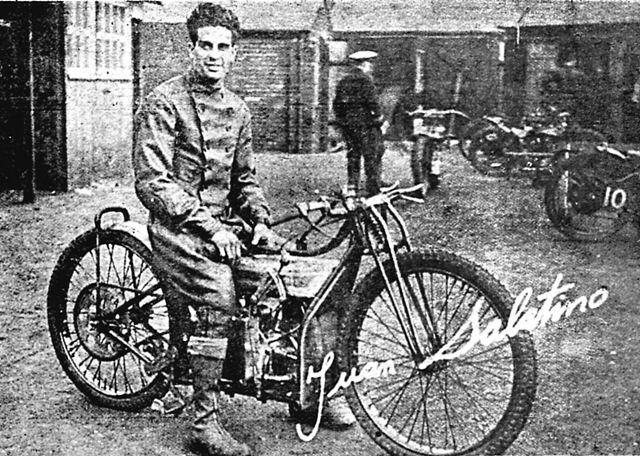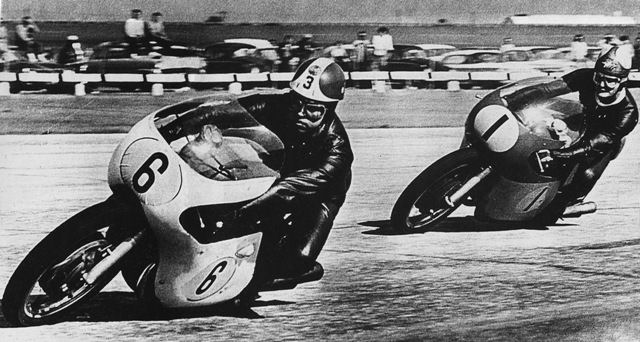




Extracts from Juan Von Martin's book Historia del motociclismo argentino
ISBN 978-987-26655-0-0 544
Historia del motociclismo argentino (extractos)
(extractos del libro Crónica, apuntes y comentarios para una Historia del motociclismo argentino, escrito por Crónica, apuntes y comentarios para una Historia del motociclismo argentino)
Año 1899
La existencia de triciclos motorizados -las tres ruedas eran un recurso muy conveniente para mantener la estabilidad, y ésta indispensable para las carburaciones y encendidos de la época- no era en ese momento ya una novedad para el ambiente local. Las noticias sobre esos vehículos pueden rebobinarse hasta el sábado 21 de enero, vísperas de la segunda jornada de competencias en el velódromo inaugurado una semana antes con la presencia del Presidente de la Nación y ministros; ese día el diario El Tiempo anunciaba que en la cuarta y última carrera “…de 40 km, por primera vez los corredores serán entrenados por el nuevo triciclo a kerosene recién introducido por la casa Recht y Lehmann. Con este nuevo elemento de progreso, los records anteriores corren la suerte (sic) de ser batidos”.
Año 1909

Historia del motociclismo argentino (extractos)
Affiche del T.C.A. Las motos, naturalmente, no eran el plato principal; pero tanto el “Circuito Buenos Aires” del M.C.A. como este “Circuito Mar del Plata” del T.C.A. contribuyeron radicalmente a desprenderlas del ámbito ciclístico y asociarlas con el motorismo en general (lo que incluyó muy pronto una nueva estrella: la “volación”).
Año 1914
Desde mediados de año, las noticias sobre la guerra en Europa -evolucionada de un atentado nacionalista en los Balcanes- consternaron a todos en la Argentina: salvo la española, casi toda la inmigración provenía de los países que tarde o temprano se involucrarían en ese desquicio. Una consecuencia, por otra parte conocida (y recordada en una famosa letra de tango) fue que pronto unos cuantos jóvenes, mayoritariamente comprometidos con la causa aliada, cruzaron el océano para combatir. El asunto incluyó a varios motociclistas locales: Heriberto y Clarencio Coldwell, Alberto Trenit, Gerónimo de La Salle, Plácido Simoni, Gerardo Wauer Alkaine, entre otros; unos murieron –como Heriberto Coldwell-, otros sobrevivieron (y sus rostros adquirieron cierta expresión remota), y algunos más se convirtieron en héroes -como el hasta entonces “gordito Paokaene”, que regresó transformado en capitán del ejército francés y con la medalla de Caballero de la Legión de Honor en el pecho, además de la Cruz de Guerra francesa, la Military Cross británica, la Cruz de Guerra belga y 11 citaciones por acciones heroicas.
Año 1920
Motociclismo

Avisos como éste debieron fascinar. Todo estaba allí, y sólo faltaba subirse. Olimpio Gori lo sabía, y también le constaba el prestigio de la marca que representaba. Pero la habilidad de Dartiguelongue para vender Harleys le había recortado un mercado que media docena de años antes había sido poco menos que propio.
Año 1924
El 4 de marzo de 1924 Pedro Perelló, José y Antonio Mas, Ceferino Bello y Antonio Carrau, todos con sidecars, iniciaron un “raid” hasta Valparaíso, en la costa de Chile, que culminó con el regreso a Buenos Aires un mes y medio más tarde. Entre las dificultades citadas en el diario de viaje resaltaban el barro de la pampa húmeda y los guadales de arena a continuación (“enterrados hasta los ejes”, “desarmando motores frente a una lona colgada de un alambrado para proteger las piezas del polvo traído por el viento”); entre las anécdotas risueñas -después de sucedidas- figuraba el terror, en el túnel transandino (de una vía y con permanentes filtraciones de agua) ante la luz de un tren a la distancia que se acercaba…convertido en un grupo de chilenos a pie a unas decenas de metros iluminándose con una vela; entre las exageraciones aparecía la altura alcanzada (“5000 metros”) cuando Las Cuevas y consiguiente entrada al túnel está a 3150. En cualquier caso, fue una aventura muy exigente, y reservada para elegidos.
Año 1931
Argentina

Juan Salatino en Europa, preparándose para una jornada de competencias con una Douglas especial para esos trámites. El hombre había comenzado su carrera deportiva a principios de los años ’20 en carreras ciclistas para menores de 16 años; a mediados de la década alternaba ya bicicletas (ganó en 1927 una Bs.As.-Santa Fe en tres etapas) con motos; reclutado en 1929 para el speedway, fue llevado a Inglaterra –donde se destacó- pero un accidente (una cadena cortada casi le arranca el pie) lo tuvo dos meses en un hospital allí; de regreso, comenzó a desarrollar lo que a lo largo de la siguiente década y media sería el tramo más brillante de su historial.
Año 1937
En septiembre de 1937 se revivía el Velox Moto Club Salta. Había sido un esfuerzo de varios entusiastas, entre ellos Ubaldo Peirone, José Loisa, Angel Monteverde, Juan N. Caro, (que conformaron la primera comisión directiva). Juan R. Otero, José A. Badía, Mario Perota, Ramón G. Perantoni, Luis Salmoral, Alfredo Medina, Mario Rondoni, Enrique Yañez, Jordán Senes y otros. Un par de meses después se animaron a una primera carrera contra deportistas jujeños, en un resultado que les fue ampliamente favorable. A fin de año contaban con 90 socios, y a fines de 1938 con unos 130. El V.M.C.S. abrió el capítulo motociclista del noroeste, hasta entonces apenas un reflejo de lo que sucedía en Tucumán.
Año 1942
motos

Los combinadores, por definición, no tenían excusas: ni pinchaduras, ni cortes de calles, ni clima adverso, ni cuestiones de salud, ni caídas. Por aquella época eran los motociclistas por excelencia: la experiencia se ganaba rápidamente en ese ámbito, más allá del bagaje previo que cada uno portara al ser reclutado (y cuyas eventuales exageraciones eran detectadas instantáneamente por el reclutador). Ser combinador
equivalía a ostentar un master motociclístico; era un título contra el que nadie confrontaba. E incluso ser amigo de un combinador daba “chapa”…
Año 1949
En julio de 1948 se anunciaba que “…José Cruz tratará de batir el record sudamericano en la ruta a Ezeiza con el modelo Rayo Negro, traído especialmente de Inglaterra a tal fin”. Efectivamente, la primera “Black Lightning” de serie (y show model en el salón londinense de Earls Court de fines de ese año) fue enviada por Philip Vincent a C.I.M.I.C. el 17 de enero siguiente, y debió llegar a fines de febrero; la idea era superar el record de Sigrand de 1930 -apenas un trámite con esa máquina- y producir un fuerte impacto publicitario en toda el área (algo que la fábrica, en graves dificultades financieras, necesitaba desesperadamente). El proyecto, sin embargo, comenzó a estirarse incomprensiblemente en el tiempo…
Año 1958
El campeonato de speedway 500cc del verano 1957-8 en Bahía Blanca -en el Club Villa Mitre- había sido ganado ajustadamente por Edgar Castellano (219 puntos) sobre Héctor Santos Ilacqua (216, campeón del año anterior) y el invitado porteño Salvador Sarda (205). Otros pilotos participantes fueron Héctor Santín, Rubén Rodríguez, Antonio y Eusebio Miranda, Julio Zecchi, Suárez, Spigardi. Paralelamente, el Bahía Blanca Automóvil Club había hecho disputar una vez más su campeonato hasta 150cc –como abultado y movido prolegómeno de sus carreras de moidgets- en la pista del Club Liniers de la misma ciudad. Aquello había finalizado con Juan Sgattoni (183 puntos) como vencedor, seguido por Carlos J. Martín (157), Gelindo Vucilli (153), Jorge Flamini (120), “Diablo Negro” (105), Guido Pioni (101), Eduardo Muñoz, J. Rodolfo, O. A. Rocha, Julio Zecchi.
Año 1964
Motoqueros

Media hora de una carrera en la que tuvo que abandonar fue suficiente para que todo el ambiente internacional hablara de Benedicto Hugo Caldarella. En diversos medios se citó al padre de Hailwood aceptando que en aquella Daytona ’64 “nunca había temido tanto una derrota”.
Año 1968
Entretanto, en un rincón impensado de la Argentina, una novedad se había estado gestando: el motocross. Luego de aquel período inicial de 1951-55 en que se propusieron por primera vez las “especialidades de campo” (en una sucesión de ajustes donde explorando la sintonía con los gustos locales se mezclaron el trial, elementos de regularidad y el motocross), una larga pausa medió hasta su reaparición. El acontecimiento tuvo un padre, que fue Jean Pierre Raemdonck van Mègrode, y un escenario quizás imprevisto: el área de Bariloche. Raemdonck era belga y campeón nacional de trial en su país; durante 1959 y parte de 1960 había recorrido en moto con un amigo toda América, desde Alaska hasta la Patagonia; y fascinado con los paisajes de los Andes había vuelto para radicarse en Villa La Angostura en 1962… aunque para nada estaba dispuesto a olvidarse de sus tiempos de éxito en Europa, y menos aún rodeado de escenarios tan propicios. Para mantenerse se dedicó a la construcción en madera de bungalows, refugios de invierno e instalaciones para pistas de esquí, y en paralelo pirueteaba con su vieja NSU Geländemax por los bosques y laderas, para recelo, curiosidad e interés (en ese orden cronológico) de los lugareños.
Año 1975
Historia del motociclismo argentino (extractos)

El último sueño del emprendimiento RK: block seis marchas, válvula rotativa, agua, escape trasero. Fue imaginado hacia 1975 y armado un tiempo después, aunque nunca fue desarrollado. Queda para la fantasía y la nostalgia imaginarlo en lascompetencias de 125 frente a las carrera-cliente europeas que se trajeron en esos años…
Fuente:
http://www.motodata.com.ar/Nota/696_historia-del-motociclismo-argentino.html
The existence of motorized tricycles- the three wheels were a very convenient resource to maintain stability and this is essential for carburaciones and burning of the period was not at that time and new to the local environment. News of these vehicles can be rewound until Saturday January 21, the eve of the second day of competitions at the velodrome opened a week before the presence of the President of the Nation and ministers; that day the daily El Tiempo announced that in the fourth and final race "... 40 km, first runners will be trained by the new tricycle kerosene newly introduced by the Recht and Lehmann house. .
With this new element of progress, the previous record run of luck (sic) being beaten "
Year 1909

Affiche TCA Motorcycles, naturally, they were not the main course; but both the "Circuito Buenos Aires" MCA as the "Circuito Mar del Plata" TCA contributed dramatically to detach them from the cycling field and associate them with motorcycling in general (which included very soon a new star: the "volación"). 1914 Since mid-year, news about the war in Europe -evolucionada of a nationalist attack in the Balkans was dismayed everyone in Argentina: except the Spanish, almost all immigration came from countries that sooner or later would be involved in this mess.
One consequence, the other known (and remembered in a famous letter tango) part was that soon some young, mostly committed to the Allied cause, crossed the ocean to fight. The issue included several local motorcyclists: Heriberto and Clarencio Coldwell, Alberto Trenit, Gerónimo de La Salle, Plácido Simoni, Gerardo Wauer Alkaine, among others; some died like Heriberto Coldwell-, others survived (and their faces acquired some remote expression), and some became heroes like the hitherto "chubby Paokaene" which he returned become captain of the French army and medal knight of the Legion of Honor in the chest, plus the French War Cross, the British Military Cross, the Belgian War Cross and 11 citations for heroic actions.
Year 1920
Announcements like this should fascinate. Everything was there, and just had to get on. Olimpio Gori knew, and also comprised the prestige of the brand it represented. But the ability to Dartiguelongue to sell Harleys had cut it a market half a dozen years before had been little more than itself.
Year 1924
On March 4, 1924 Pedro Perello, Joseph and Antonio Mas, Ceferino Bello and Antonio Carrau, all with sidecars, initiated a "raid" to Valparaiso on the coast of Chile, culminating with the return to Buenos Aires a month and a half later. Among the difficulties cited in the travel diary they highlighted the mud of the humid pampas and guadales sand below ( "buried up to the axles", "disarming engines face a hung from a fence to protect parts from dust brought canvas by wind"); -after between laughing anecdotes contained sucedidas- terror in the trans tunnel (one - way and permanent water seepage) before the light of a train approaching the distance ... it becomes a group of Chilean walk tens of meters brightening with a candle; between the exaggerations appeared the height reached ( "5000 meters") when Las Cuevas and consequent entrance to the tunnel is 3150. In any case, it was a very demanding adventure, and reserved for elected.
Year 1931

Juan Salatino in Europe, preparing for a day skills with a special Douglas for those procedures. The man had begun his career in the early ' 20s in cycling races for children under 16 years; to mid he alternated and bicycles (won in 1927 the Buenos Aires-Santa Fe in three stages) with motorcycles; recruited in 1929 for the speedway, he was taken to England , where it destacó- but an accident (a broken chain almost snatches foot) it had two months in a hospital there; back, he began to develop what over the next decade and a half would be the brightest in its history section.
Year 1937 In September 1937 he relived the Velox Moto Club Salta. It had been an effort of several enthusiasts, including Ubaldo Peirone, José Loisa, Angel Monteverde, Juan N. Caro (who formed the first commission directive). Juan R. Otero, José A. Badía, Mario Perot days, Ramon G. Perantoni, Salmoral Luis Alfredo Medina, Mario Rondoni, Enrique Yanez, Jordan Senes and others. A couple of months later encouraged jujeños first race against athletes, a result that was largely favorable to them. At year 's end they had 90 members, and by the end of 1938 about 130. The VMCS motorcyclist opened the Northwest chapter, then to just a reflection of what was happening in Tucuman.
Year 1942

Combiners, by definition, had no excuses: or punctures, cuts or streets or adverse weather, or health issues, or falls. By that time were motorcyclists par excellence quickly gained experience in this area, beyond the previous baggage that each portara to be recruited (and whose eventual exaggerations were detected instantly by the recruiter). Combiner be tantamount to bear a motociclístico master; It was a title against anyone confronted. And even be friends with a combiner was "plate" ...
Year 1949 In July 1948 it was announced that "... Jose Cruz will try to beat the South American record en route to Ezeiza with the model Ray Black, specially brought from England for this purpose" . Indeed, the first "Black Lightning" series (and model show at London 's Earls Court room late that year) was sent by Philip Vincent to CIMIC January 17 next, and should arrive in late February; the idea was to beat the record of Sigrand 1930 barely a formality with the machine- and produce a strong advertising impact throughout the area (something that the factory in serious financial difficulties, desperately needed). The project, however, began to stretch incomprehensibly in time ...
Year 1958
The 500cc championship speedway summer in Bahia Blanca 1957-8 -in the Club Villa Mitre had been won fittingly by Edgar Castilian (219 points) on Hector Santos Ilacqua (216, champion last year) and the Buenos Aires invited Salvador Sarda (205). Other participants were Hector Santín pilots, Ruben Rodriguez, Antonio and Eusebio Miranda, Julio Zecchi, Suarez, Spigardi. In parallel, the Automobile Club Bahía Blanca had once again play his 150cc championship until prolegómeno bulky and moved their careers on track moidgets- Club Liniers like the same city. That had ended with John Sgattoni (183 points) as the winner, followed by Carlos J. Martin (157), Gelindo Vucilli (153), Jorge Flamini (120), "Black Devil" (105), Guido pioni (101), Eduardo Muñoz, J. Rodolfo, OA Rocha, Julio Zecchi.
Year 1964

Half an hour of a race in which he had to leave was enough for the whole international atmosphere Benedict spoke of Hugo Caldarella. . In various media quoted the father of Hailwood accepting that Daytona in '64 "had never been so afraid defeat"
Year 1968
Meanwhile, in an unexpected corner of Argentina, a novelty had been brewing: motocross. After that initial period 1951-55 in which first proposed the "specialty field" (in a succession of settings where exploring attuned to local tastes the trial, regular elements were mixed and motocross), a He brokered long pause until its reappearance. The event had a father who was Jean Pierre van Raemdonck Mègrode, and perhaps unexpected scenario: Bariloche area. Raemdonck was Belgian national champion and trial in his country; during 1959 and part of 1960 there were bike ride with a friend across America, from Alaska to Patagonia; and fascinated by the landscapes of the Andes had returned to settle in Villa La Angostura in 1962 ... although nothing was willing to forget their times of success in Europe, and less still surrounded by so favorable scenarios. To stay he devoted himself to building wood bungalows, winter shelters and facilities for skiing, and parallel pirueteaba with his old NSU Geländemax by forests and hillsides, to suspicion, curiosity and interest (in that chronological order) the locals.
Year 1975

The ultimate dream of entrepreneurship RK: block six - speed rotary valve, water, rear exhaust. It was imagined by 1975 and armed a while later, but was never developed. It is for fantasy and nostalgia lascompetencias imagine in 125 against the race-European customer who brought in those years ...
Unrelated to this article...
Peter Henshaw in his Encyclopedia of the Motorcycle says when commenting
on an Australian built machine words to the effect that Australians are
not known for their prowess in the world of motorcycling. It seems that
in Argentina that was not quite true.

Sources: historia-del-motociclismo-argentino, Wikipedia